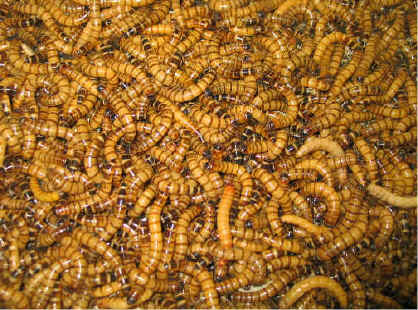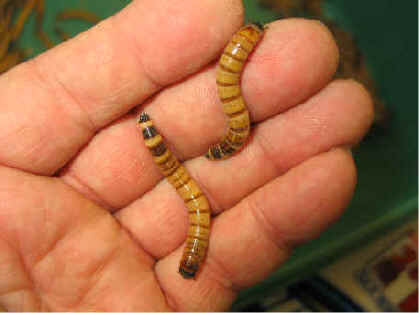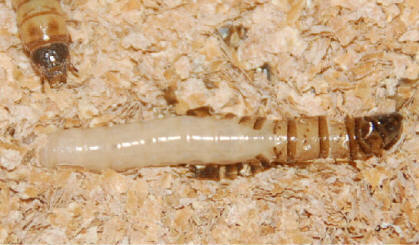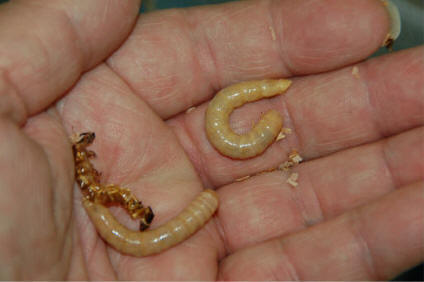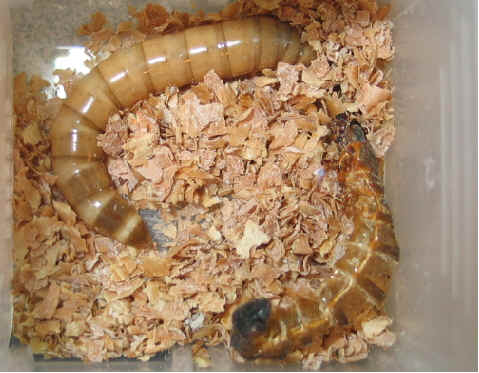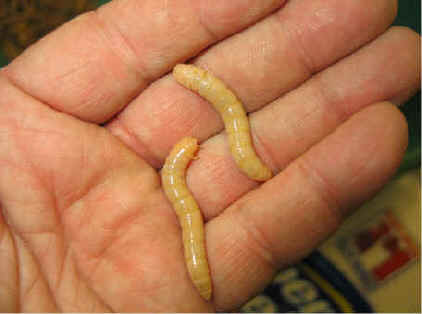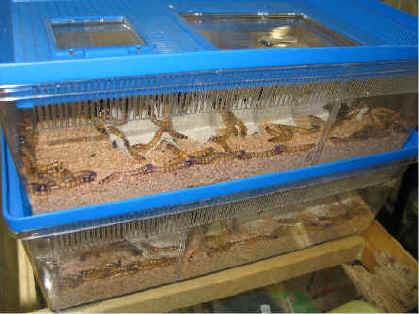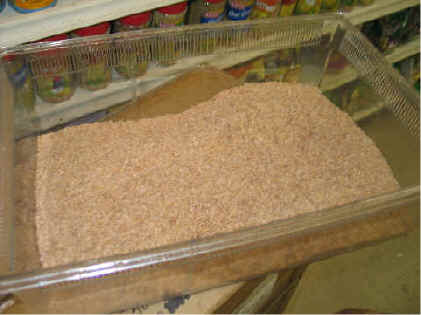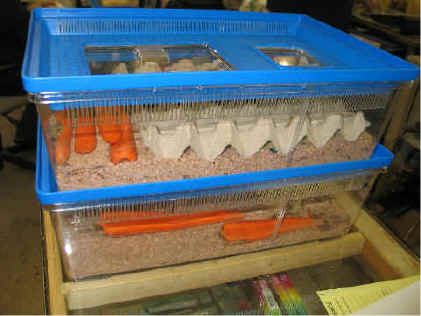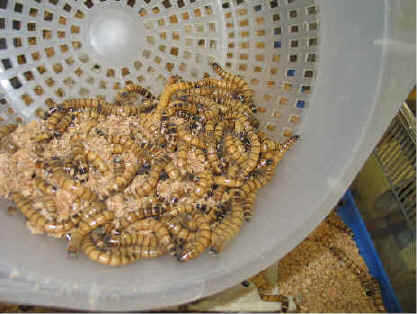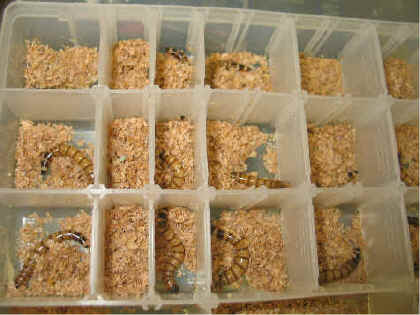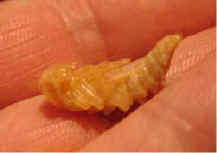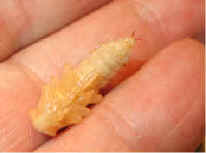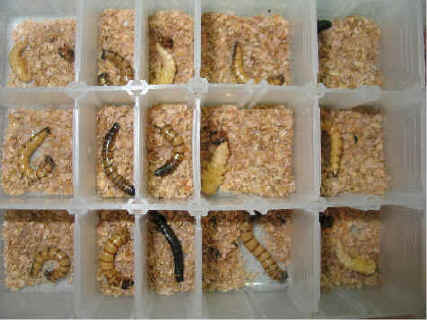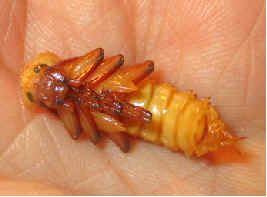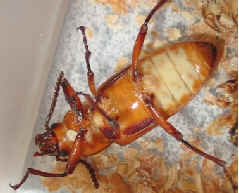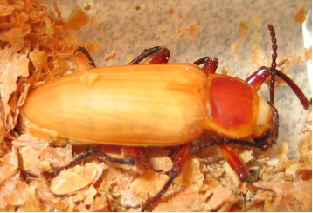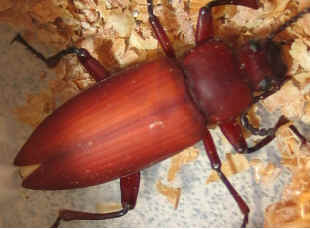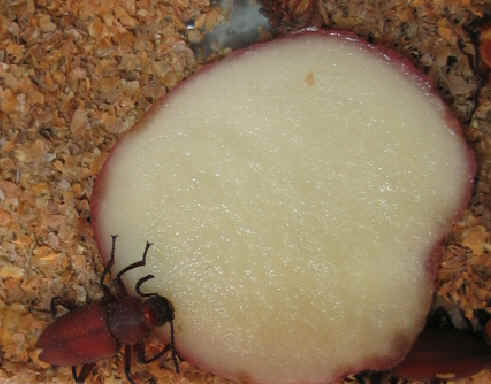|
This care sheet has been adapted from one available from LA Productions* The scientific name for the Superworm is Zophobas morio.
The Super worm is also known by another common name, Kingworm. Superworms
are used for feeding reptiles, birds, and for bait. They take much longer
to pupate than the mealworm. Superworms do not require and should not
be refrigerated, How To Breed Superworms When your superworms are at least 4 months old or 50 to 60 mm long, they are old enough to breed. Breeding superworms is a long term process, by the time you have food size worms again, it will have been about 3 - 4 months. If you have many mouths to feed, breeding superworms can be very economical. The first thing you need is individual compartments to force the worms to pupate. Many people use film canisters, workshop screw/nail drawer units, or embroidery floss cases. Drill or melt a small hole in the top of each compartment, and add a small amount of oats to the bottom of each one. You can start the breeding process with a minimum of 50 superworms. Starting with 50 superworms will eventually yield approx. 3000 superworms over several months. Put one superworm in each compartment. Do not add any moisture source. Store the containers in a dark, warm (20 - 25C) area. You will not need to feed them again until they become beetles. Within 14 days, the worms will curl up, preparing to pupate. Any that are black and straight are dead and should be thrown away. Within another 14 days they become pupae. Once you notice pupa, you should check on them daily or so to watch for beetles. In another 2 weeks or so, they become beetles. The beetles are white, then red, and finally turn black within 24 hours of becoming beetles. Beetles should be removed to the breeding tank. Plastic containers makes a good beetle houses. Drill holes in the lid for ventilation. Using the same substrate you would use for the worms, cover the bottom of the tank with substrate. Add several stacked egg crates for the beetles to lay eggs on and hide in. The beetles will be very hungry and thirsty after their metamorphisis. Provide moisture using the same vegetables as you would with superworms. The beetles do not need light, and seem to prefer darkness, but should be kept at 70 - 80 degrees to encourage breeding. In 7 - 14 days, there will be eggs within the egg crates and substrate, although you probably will not see them - they are very small. Removing old food becomes tedious at this point because the eggs and baby superworms are too small to see and may be in the food. Throw old food into a seperate container and keep an eye out for small worms. Every 2 weeks, remove all substrate to another container so the beetles won't eat the baby superworms. Add new substrate to the beetle container. You will need to do this every 2 weeks or so for 4 or 5 months. Soon you will find many small worms in your worm tank. These will get full size within a few months when you can begin the cycle again.
Origin. Frankly, I don’t know where these feisty “worms” originally came from exactly. I can narrow it down to Central and South America. Happily, they are readily available commercially. Un-Worms. First, superworms are really insects – the larval form of a chunky beetle. Excuse us for calling them worms. But, gee, mom, everyone else does it.
Size. Superworms grow to a hefty 50mm long. You will not feed these guys to small lizards. You can get a good idea of their size from their picture. Biters. Don’t toss a raft of these guys in with your lizard regardless of size. These guys can bite. They’ll bite your lizard (and you) – especially if you overfeed. Superworms even gnaw their way out of those hard plastic cups they are sold in. They start chewing on one of the pin-sized air holes and make it large enough to wriggle out of. Feeding Technique. If you just toss your superworms into your lizard tank, they will burrow into your lizard’s substrate and “bug” your hungry lizard later. Put them into a slick-sided container with sides too high for them to clamber out of – sort of a lizard buffet.
Recent Instars. Superworms that just finished “molting” are softer and easier to chew. Doubting Thomas? Try a test bite or two. Increase Their Nutrition. You can successfully keep your superworms in the original medium they came in. But before you feed them to your critter of choice, you may want to gut load them or as the Governator says “We will plump them up.” Put them in a small container with a highly nutritious food – any of the cricket gut loading foods will work. We use chicken egg-laying mash. You cannot dust them like crickets because of their Teflon-like exoskeleton.
Housing. Any kind of slick-sided container with a ventilated top will work. A tightly sealed lid runs up the humidity and encourages mold.
Culture Medium. We tried some different media and finally came back to plain old bran. Superworms, eat, hide in, and breed in their media. It will probably last two months before they totally consume it.
Water Source. We prefer carrots as their water source. Without the carrots, they devour each other for moisture. You find a lot of dried heads with no bodies attached. Potatoes and apples also work but not as well. Apples seem to increase the humidity too high.
Capturing Hint. If you leave something opaque on the surface, many of your superworms will congregate immediately below its surface. They do not like the light and prefer to spend most of their time below the surface of their media.
August 27, 2005. First pupa emerges
Pupa Comments. You actually have to force superworms to pupate. Otherwise, they remain larvae. The ones that curl up (above) tend to pupate successfully in a couple of weeks. Some people use those tubes film comes in You gotta punch a small hole in it. Add a bit of bran and check every so often. We use that 24-section tackle box above. It costs $3 and lets you see all your potential pupae with a minimum of effort. Separating the individual larvae protects the pupae from their cannibalistic brethren.
Pupae develop into beetles that redden over time. They need a bit of moisture at this time. Beetle Comments. Your pupae will convert to beetles in another week or two. These beetles are the breeders of your next generation. Each mama beetle lays hundreds of eggs. I’ve never counted them so I can’t give you an exact number. They lay eggs in your media for at least two months. Last Word. Few people want to breed their own superworms. However, now you know how it’s done. *© 2005 LA Productions
|
||||||||||||||||||||||||||||||||||||||||||
